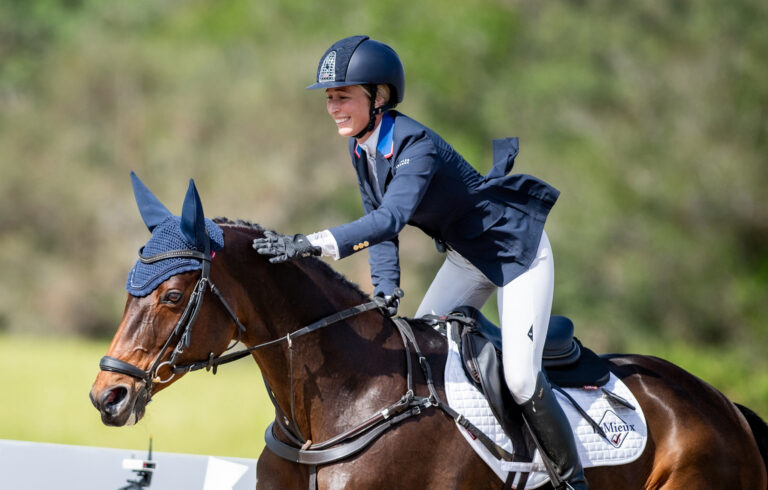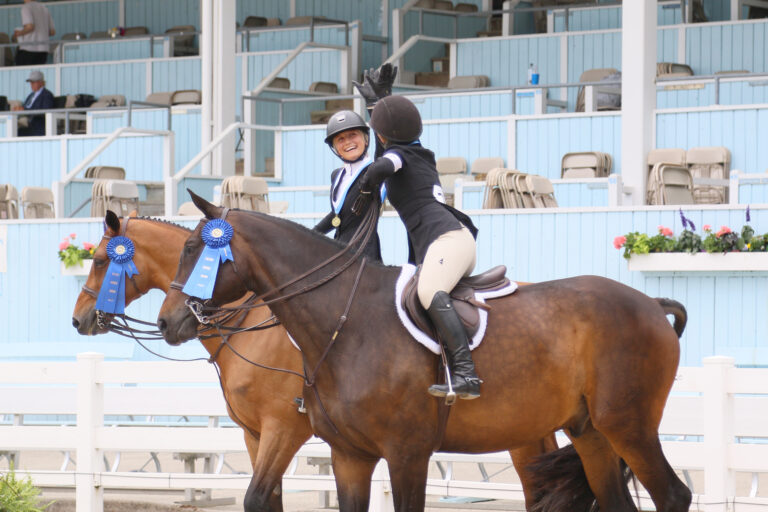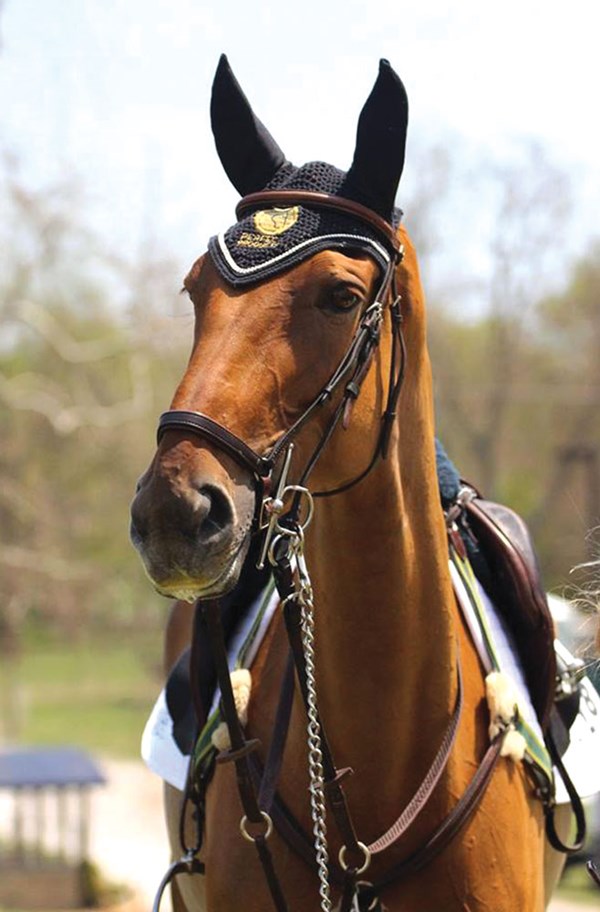
World-class eventer RF Demeter has a team of barn staff, sponsors, veterinarians and farriers to keep her at the top of her game. “If Demi feels anything other than her best, for example, her farrier would come out to make sure her angles are all just right or out vet might come to watch her work. Everybody gives 100 percent, just as Demi always does,” said rider Marilyn Little.
Learn more about the mare’s quirks and how her team keeps her happy, healthy, and performing at her best.
RF Demeter
Nickname: Demi, Goldfish or The Fish
Occupation: Eventer
Hometown: Frederick, Maryland (summer), and Ocala, Florida (winter)
Basic stats:
Breed: Dutch-bred Oldenburg
Sire: Rubin Royal
Dam: Patricia
Age: 14
Sex: Mare
Height: 16.2 hands
Demeter’s people:
Owners: Team Demeter LLC (Jacqueline Mars, Raylyn Farms, Patrick and Eileen Witte)
Rider: Marilyn Little
Exercise rider: Helene Emond
Stable manager: Katie Brown
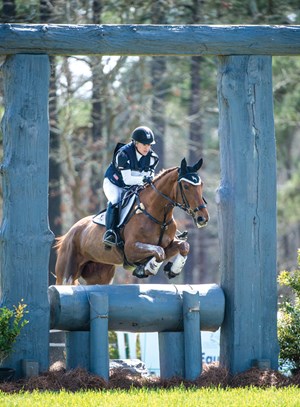
Major accomplishments: In 2012, Demi placed ninth in her first CCI**** at the Rolex Kentucky Three-Day Event with Marilyn, who competes at the top levels in both eventing and jumpers. The next year, she was named the U.S. Eventing Association Horse of the Year and Mare of the Year and was the top-ranked mare in the FEI/World Breeding Federation for Sport Horses event horse rankings. To date, she has won four three-star competitions—including last fall’s Poplar Place CIC***, Morven Park CIC*** and Bromont CCI***—and has completed five four-star competitions.
Background: Dutch eventer Raf Kooremans was competing Demi at the three-star level in Europe in 2011 when Marilyn selected her as one of two horses for Olympic veteran Karen O’Connor to consider. Karen chose the other horse, Mr. Medicott (her eventual 2012 Olympic partner), so Marilyn formed a syndicate to purchase Demi for herself to ride.
“She’s a very sensitive horse and a wonderful worker but very high energy and busy,” Marilyn says. “Other riders can hack her and do her trot sets, but she doesn’t tolerate multiple riders training her. I do all of her gallops and schools.”
Demi is a cribber—she wears a Miracle Collar in the stall. She also will walk the fence line when she’s had enough turnout for one day so she’s always monitored. She’ll become restless in the paddock if she feels she’s been rested for too long at the end of the season. Marilyn usually gives her two major downtimes each year in the fall and spring. “She lets us know how much is enough. If she starts walking the fence line, we hack her for the rest of the downtime.”
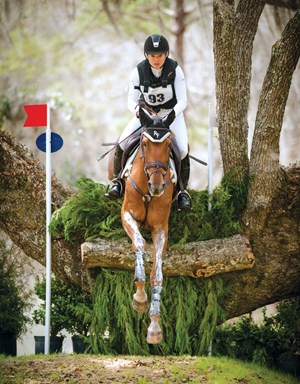
Blowing off steam is critical for the mare, Marilyn adds. “Demi is a truly kind soul, and a child could lead her around the yard or play with her in the stall. Yet, if she misses a gallop, she can be cheeky to be around. The occasional nip and/or flying hind leg in the grooming stall are part of the deal.”
Although Demi’s strong suit is cross country, she has an aversion to open spaces. She prefers a small paddock near the barn. At competitions, she must be longed in small spaces, such as the corner of a ring. Otherwise, says Marilyn, “She stares off into the distance and panics.” The mare also dislikes loud machinery, such as tractors and lawn mowers.
One of the biggest challenges with Demi is keeping weight on her when she’s extremely fit. With about 50 percent Thoroughbred blood, she has the big-boned frame of a warmblood but the metabolism of a Thoroughbred.
Daily routine: Demi has an extra-large stall in the old foaling barn. “It’s quieter and not as busy as the barn where we have the jumpers,” says Marilyn. “She has the only door to the outside, which she loves to look out of. We put her haynet next to it so she can see out while she eats. In the winter, we bundle her up in a Back on Track blanket and neck cover, so she can still put her head out.”
Bedding Demi on straw has made a big difference in maintaining her weight. She nibbles on it throughout the day, which adds fiber to her diet and aids her digestion. Marilyn also thinks it’s helped to bring out the bloom in the mare’s coat.
To stay happy, Demi needs to get out of her stall several times a day, starting with turnout from about 7 a.m. to 9:30 or 10 a.m., depending on how long she’s quiet. Then she exercises for about 45 minutes either on the treadmill or walker. The latter is European-style, built on a very large circle with moving partitions so horses walk untied in their individual stalls with a nonslip concrete surface. This provides the bone strengthening that European eventers achieve by hacking on roads. (Marilyn doesn’t think traffic is safe enough for riding on U.S. roads.)
Early in the season, Demi does strengthening programs on the Horse Gym USA® treadmill, which has nine different exercise programs. Later in the season, when she’s achieved peak fitness, she does a lighter program. “At that point, the walker or treadmill is merely keeping her busy. She does less time than the other horses because we’re trying to keep the weight on.”
Of her six weekly rides, two to three are dressage and one is a trot set. Once she has reached her peak fitness, Marilyn takes advantage of the fact that she is so experienced and jumps only once or twice in the week before an event to prevent unnecessary wear and tear on her legs. She gallops every five days. “She loves her gallops,” says Marilyn. “She has to be the lead horse, setting the pace. Otherwise she’ll drag you to the front.”
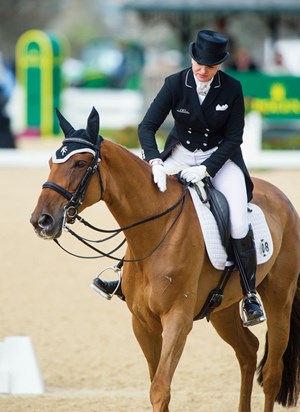
Between workouts, Demi gets a good grooming, which she tolerates, says Marilyn, “so long as you’re gentle. She’s very thin-skinned with not a lot of fat.” She doesn’t like being curried but does like being rubbed down with towels. “We are careful not to wash her too much, as that depletes the protective oils in her coat, which would make her more susceptible to boot rubs, etc. Plus, keeping her feet and heels dry helps keep them from getting too soft, which could lead to sore feet.” Demi’s caretakers don’t ever poultice her legs because the moisture in poultice (and the necessary washing afterward) can deplete her skin’s oils in the same way.
“We body clip her regularly,” Marilyn adds, “probably nine times a year because she gets so many vitamins and nutrients and grows her coat so quickly.”
After more strenuous workouts, such as gallops, jump schools or competition days, Demi wears Back on Track leg wraps, which Marilyn says help to minimize inflammation and increase circulation. “Sometimes when we’re letting her down at the end of the season, her legs get a little stocked up, too. So she also wears them then.”
Nutrition: Marilyn’s greatest discovery in her struggle to maintain Demi’s weight is a probiotic called EquioticTM. Since she started the mare on it in 2013, she’s seen a remarkable transformation in her appetite, stamina and performance. “I don’t think she ever made the time on cross country before that. She just didn’t have the staying power. Now she makes the time. She put on more weight, her coat got shinier and she became less agitated.”
Demi is a very picky eater. She’s also “a genius” at sifting out the grain and leaving supplements at the bottom of the bucket, so Marilyn feeds her Nutrena Fibregized Omega feed, which binds well to the supplements. It’s also high in fat, fiber and other nutrients, which help to keep the weight on. Most importantly, says Marilyn, “she likes it.”
Demi’s supplements include biotin, EnviroEquineTM ElectroBalance (electrolytes and minerals) and GastroBalance (for hydration and gastrointestinal support), Wild Gold oil (a plant-based fatty- acid supplement, which helps with fighting inflammation) and Perfect Products TRF Tendon Repair Formula, which supports soft-tissue structures. Since she started the TRF last June, Marilyn says, “I’ve noticed her recovery is better after gallops and events.”
During the event season, Demi eats a timothy–orchard grass hay. “Alfalfa gives her too much energy,” says Marilyn, “so we only give that to her in the off-season.” For treats, she prefers carrots. “She won’t have apples.”
Other care: In the spring, says Marilyn, “Demi benefits from and seems to enjoy shock-wave therapy from time to time on her gluteal and lower lumbar muscles. These muscles tend to get sore as she’s developing her fitness. Because of the way she’s built—a little high behind—she’s a great galloper and has wonderful power. But for dressage, it’s a constant struggle to get her to ‘sit’ better.”
At shows, she is frequently hand-walked and longed at a slow trot “so she can collect her thoughts.” She also receives massages and acupuncture.
Her hooves grow quickly so she is shod every three and a half to four weeks. Although she stands a little toed-in and wings out with one foreleg, Marilyn says, “she has great feet.”
Marilyn believed that Demi suffered from ovarian pain when she first came to her barn. “She had painful cycles that seemed to be accompanied by back soreness and muscle tightness.” These symptoms improved when she began receiving a daily synthetic oral hormone, Altresyn®.
Demi travels three to four days a week for gallops, jump schools and shows, always in her preferred position: on the driver’s side, facing backward. She’s the designated babysitter on the road; Marilyn puts difficult shippers next to her because she helps them settle. “She’s always been very happy to travel; she knows it’s part of her job. Her businesslike manner on airplanes, ferries and trucks is always surprising given the fact that she is a chestnut mare to the core!”
This article originally appeared in the January 2016 issue of Practical Horseman.





